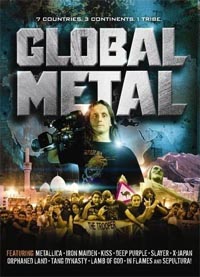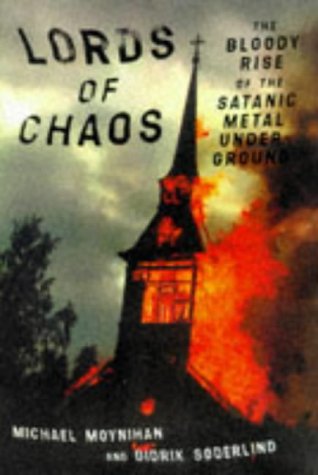(VH1 Productions, 2006, 60 Min)
 What is excellent about this documentary is its bonehead simplicity in tracing the history of metal. It focuses on nodal points where single events touched off nascent convergences and caused paradigm shifts. Not all of these are musical events; much of the footage is devoted to showing how changes in history prompted changes in metal. This attitude allows it to peer into the motivation behind metal musicians more than any other documentary extant. The strength of this documentary is its star power in pulling in all of the classic figures in heavy metal for interviews. The big names show up, and get put at ease and asked questions by people whose journalistic intent matches a fascination with rock music as an event. When their answers are put in context, the result is metal history like a scrolling tapestry passing our eyes. The centerpiece of this documentary are the glam years of Hollywood bands from Van Halen to Guns and Roses, and much of it is intended to make them look more sophisticated and intense than their European counterparts who invented the genre. Speed metal gets an offhand mention, and underground metal gets entirely skipped. Its focus is not surprisingly on the kind of metal that makes it to the VH1 video channel and makes pots of money. In its coverage of glam rock, power ballads, bad boy rebels and drug abuse this film is most lucid. Humorously, the glam rockers, twenty years later, look somewhat diseased, while Tommy Lee still looks vile and combat-ready. Even funnier: of all the people interviewed, a remarkably self-confident and unpretentious Sebastian Bach is the most articulate and uncomplicated. Unfortunately, other parts of the film portray metalheads as wounded, out-of-control children who make this horrible, violent music because they’re defective. While these flaws weaken the documentary, and disable it more in post-viewing analysis when the viewer realizes the documentary’s weaknesses stem from a desire to productize one of the last un-zombie’d genres, “Heavy: The Story of Metal” has many positive factors, not least of all the simplest: the people who made it clearly enjoy metal music and wanted to portray it in a positive light, even if their definition of positive was twisted by their pocketbooks.
What is excellent about this documentary is its bonehead simplicity in tracing the history of metal. It focuses on nodal points where single events touched off nascent convergences and caused paradigm shifts. Not all of these are musical events; much of the footage is devoted to showing how changes in history prompted changes in metal. This attitude allows it to peer into the motivation behind metal musicians more than any other documentary extant. The strength of this documentary is its star power in pulling in all of the classic figures in heavy metal for interviews. The big names show up, and get put at ease and asked questions by people whose journalistic intent matches a fascination with rock music as an event. When their answers are put in context, the result is metal history like a scrolling tapestry passing our eyes. The centerpiece of this documentary are the glam years of Hollywood bands from Van Halen to Guns and Roses, and much of it is intended to make them look more sophisticated and intense than their European counterparts who invented the genre. Speed metal gets an offhand mention, and underground metal gets entirely skipped. Its focus is not surprisingly on the kind of metal that makes it to the VH1 video channel and makes pots of money. In its coverage of glam rock, power ballads, bad boy rebels and drug abuse this film is most lucid. Humorously, the glam rockers, twenty years later, look somewhat diseased, while Tommy Lee still looks vile and combat-ready. Even funnier: of all the people interviewed, a remarkably self-confident and unpretentious Sebastian Bach is the most articulate and uncomplicated. Unfortunately, other parts of the film portray metalheads as wounded, out-of-control children who make this horrible, violent music because they’re defective. While these flaws weaken the documentary, and disable it more in post-viewing analysis when the viewer realizes the documentary’s weaknesses stem from a desire to productize one of the last un-zombie’d genres, “Heavy: The Story of Metal” has many positive factors, not least of all the simplest: the people who made it clearly enjoy metal music and wanted to portray it in a positive light, even if their definition of positive was twisted by their pocketbooks.
No Comments
 m Dunn takes to the air to visit different parts of the world where heavy metal is booming. In doing so, he acknowledges the transition the genre has made from being a developing movement in the west, to a genre which has reached an end to its maturation and now is another voice into which others project. Indeed, as he visits anti-religious metalheads, religious metalheads, anti-Zionist metalheads and Zionist metalheads, teen rebels and people looking for a voice for their ancestral cultures that can compete with the booming sound of the West, Dunn discovers a change in metal. No longer is it being absorbed by a global audience, but changed by a global audience. He does this through a winding narrative featuring many shots of the director, often using his bemused poker face to poke innocently where trouble might lie. Knowing that interviews alone make a boring documentary, he intersperses them with tour de force cinematography that shows us the vastness and beauty of these different places, and music videos mostly featuring concert shots from each location. The intelligent choice here is to avoid “norming” places by emphasizing the we’re-all-the-same message. Dunn lets his camera and his subjects do the talking, although his frequent voice-over covers the boilerplate dogma we’re accustomed to hearing: metal is about self-expression, freedom, free speech, being an individual, and so on. But as time goes on, we see how metal is about being in a group that accepts the individual’s desire for rage and figuring things out themselves. Dunn’s final narrative affirms this: metal is a worldwide subculture to which people belong more than the politics of their nations. It is as if through his eyes, metal is a shout of rage at the modern world which has assimilated culture in its manic desire for power and commerce, and the insurgent forces of Hessians worldwide are reclaiming culture by first distancing themselves from it. For the person who is rightfully as cynical of the nitwit pretensions of individuals as of the face of state power, many of the people interviewed come across as surface treatments, and this is a general criticism of Dunn’s films we have all heard before. In the name of making them accessible, he pushes back the anthropology in favor of reveling in the power of the movement itself. For now, that’s not half bad.
m Dunn takes to the air to visit different parts of the world where heavy metal is booming. In doing so, he acknowledges the transition the genre has made from being a developing movement in the west, to a genre which has reached an end to its maturation and now is another voice into which others project. Indeed, as he visits anti-religious metalheads, religious metalheads, anti-Zionist metalheads and Zionist metalheads, teen rebels and people looking for a voice for their ancestral cultures that can compete with the booming sound of the West, Dunn discovers a change in metal. No longer is it being absorbed by a global audience, but changed by a global audience. He does this through a winding narrative featuring many shots of the director, often using his bemused poker face to poke innocently where trouble might lie. Knowing that interviews alone make a boring documentary, he intersperses them with tour de force cinematography that shows us the vastness and beauty of these different places, and music videos mostly featuring concert shots from each location. The intelligent choice here is to avoid “norming” places by emphasizing the we’re-all-the-same message. Dunn lets his camera and his subjects do the talking, although his frequent voice-over covers the boilerplate dogma we’re accustomed to hearing: metal is about self-expression, freedom, free speech, being an individual, and so on. But as time goes on, we see how metal is about being in a group that accepts the individual’s desire for rage and figuring things out themselves. Dunn’s final narrative affirms this: metal is a worldwide subculture to which people belong more than the politics of their nations. It is as if through his eyes, metal is a shout of rage at the modern world which has assimilated culture in its manic desire for power and commerce, and the insurgent forces of Hessians worldwide are reclaiming culture by first distancing themselves from it. For the person who is rightfully as cynical of the nitwit pretensions of individuals as of the face of state power, many of the people interviewed come across as surface treatments, and this is a general criticism of Dunn’s films we have all heard before. In the name of making them accessible, he pushes back the anthropology in favor of reveling in the power of the movement itself. For now, that’s not half bad. discussed in Dark Planet – straightedge, skinhead, black metal and zealot – present themselves as alternatives to the mainstream ways we envision our future. Unlike the normal Simpsons-style happy oblivion in which most consumers live, these youth culture groups believe our current path leads to ruin, and are forming breakaway societies. Luckily, the film takes a documentarian’s delicate outsider approach to outsiderness: observe, ask the logical questions, and then boogie. Here is the great strength of their approach: they are able to approach these cultures as an athropologist would, without judging or fearing for their own political futures, because they treat them all so evenhandedly. If you ask this reviewer, the zealots — separatist Christian ideologues — really run away with the show by having a clear plan unlike the other three groups. Their culture, based in distorted loud music as well as the other three, emphasizes a rising above instead of a fighting back or burning the world. Like the other groups, however, their methods do not seem particularly effective. Seeing these movements compared helps us see the point of this film: that many people agree things are going wrong, but have no idea what to do about it because the insider mainstream is never going to budge from its position of convenience-first, so people are creating alternate societies within societies. This film like all good documentaries provides a visual feast of information with an aftertaste of introspection.
discussed in Dark Planet – straightedge, skinhead, black metal and zealot – present themselves as alternatives to the mainstream ways we envision our future. Unlike the normal Simpsons-style happy oblivion in which most consumers live, these youth culture groups believe our current path leads to ruin, and are forming breakaway societies. Luckily, the film takes a documentarian’s delicate outsider approach to outsiderness: observe, ask the logical questions, and then boogie. Here is the great strength of their approach: they are able to approach these cultures as an athropologist would, without judging or fearing for their own political futures, because they treat them all so evenhandedly. If you ask this reviewer, the zealots — separatist Christian ideologues — really run away with the show by having a clear plan unlike the other three groups. Their culture, based in distorted loud music as well as the other three, emphasizes a rising above instead of a fighting back or burning the world. Like the other groups, however, their methods do not seem particularly effective. Seeing these movements compared helps us see the point of this film: that many people agree things are going wrong, but have no idea what to do about it because the insider mainstream is never going to budge from its position of convenience-first, so people are creating alternate societies within societies. This film like all good documentaries provides a visual feast of information with an aftertaste of introspection. Lords of Chaos – Michael Moynihan
Lords of Chaos – Michael Moynihan
